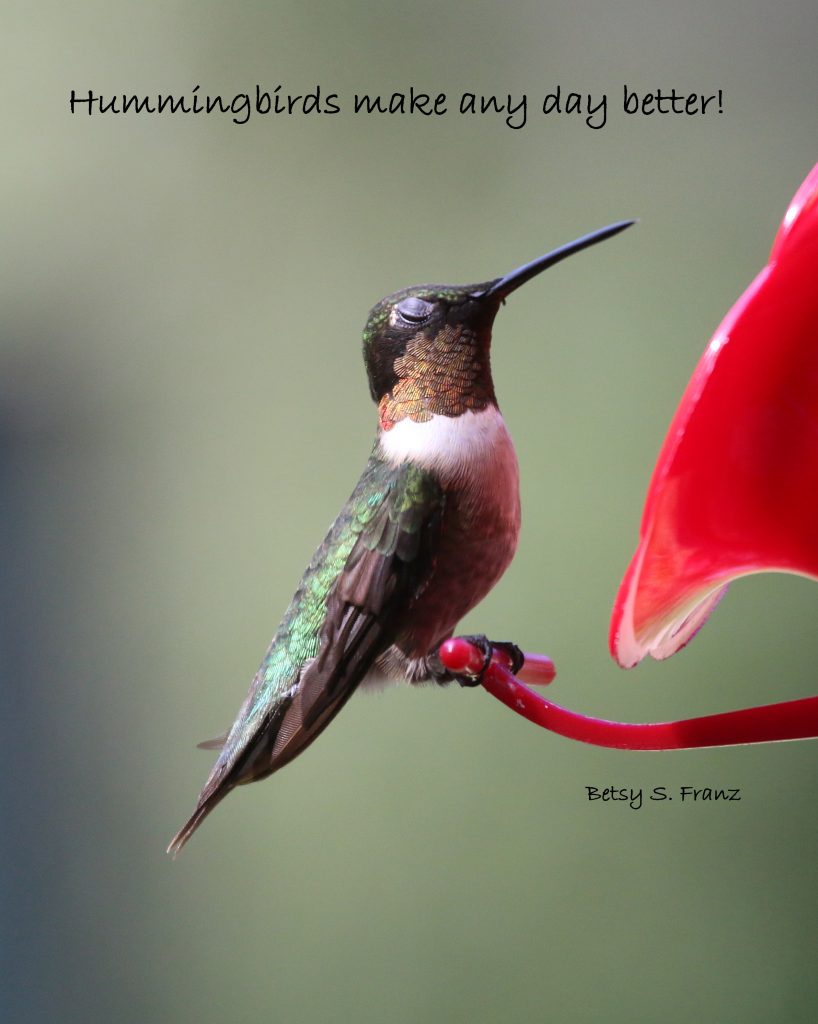 One of the most stunning and sometimes surprising joys of a wildlife friendly landscape is the presence of hummingbirds.
One of the most stunning and sometimes surprising joys of a wildlife friendly landscape is the presence of hummingbirds.
Many people believe that there aren’t any hummingbirds in central Florida. These tiny birds are fast and elusive and often go un-noticed by gardeners who think that the only trick to attracting them is hanging up a nectar feeder.
It is true that hummingbird populations are not as high in Florida as in many other states. Some out-dated reference sources on hummingbirds still say that the ruby throated hummingbird is the only hummingbird east of the Mississippi. However, the Florida Ornithological Society now has confirmed sightings of ten different hummingbird species in our state. These are the Ruby-throated, Buff-bellied, Black-chinned, Rufous, Calliope, Allen’s, Anna’s, Broad-tailed, Broad-billed and Bahama Woodstar hummingbirds.
These statistics show that there are actually many more hummingbirds in Florida than we were once led to believe.
Fred Basset, a nationally recognized hummingbird bander, was the first to band and verify two of these more uncommon species in Florida, the Anna’s and the Broad-billed.
“I am convinced hummers have been here all along, but not many were seen”, Bassett said. “Birding books didn’t report many sightings so people didn’t leave out feeders or garden for them. If someone reported wintering hummers, they were told they were mistaken and that they had probably seen a moth. It’s no wonder they weren’t reported.”
Basset thinks the number of hummingbird sightings in Florida will increase if more people will just start gardening for them. “I have no doubt many more of them will start showing up as more people garden for them and maintain feeders during the winter,” he said.
The best way to attract hummingbirds in a central Florida yard is to provide their favorite types of plants: colorful, tubular flowers for feeding will attract the tiny birds, and tall trees for perching and protection will entice them to stay.
Hummingbirds are not attracted by a flower’s scent but by its color. They are thought to prefer red, orange and pink flowers but this color attraction is not a trait that they are born with. Instead, they learn by trial and error which flowers give the best results. Tubular blossoms are hummingbird favorites because they generally hold large amounts of nectar at their base, and the hummers long needle like bills and specially adapted tongues allow them to easily reach it. In addition, the tubular flower structure limits competition from bees and other insects. In Brevard County yards, some of the hummingbird favorites are firebush, coral honeysuckle, salmon porterweed, firespike, firecracker plant, cigar plant, scarlet sage and even hibiscus.
Since sightings indicate that hummingbirds remain in Brevard year round, your best bet for attracting hummingbirds to your yard is to provide plants that have different blooming periods.
Hummingbirds are very territorial, so plants should be spaced in separate groupings around your yard and at varying heights, starting at about 18†above the ground. Since they feed in flight, they need plenty of room around the flowers to accommodate their movements.
When they aren’t eating, hummingbirds spend their time sitting and keeping an eye on their food source, so trees and tall shrubs should be planted within sight of the feeding areas.
To be able to observe hummingbirds, try to position your gardens so that they can be viewed from an inside window.
Hanging flowering plants and nectar feeders, which can be placed almost anywhere, will increase your opportunities to catch a glimpse of these elusive birds. However, nectar feeders need to be maintained correctly to not harm the hummingbirds.
A simple nectar solution can be made by combining 1 part granulated sugar to 4 parts water in a saucepan and boiling for two minutes. The mixture must be cooled completely before filling feeders and unused portions must be refrigerated. Hummingbirds find this mixture very appealing, but it provides little nourishment, so feeders should not be the only food source provided. Using a sweeter solution, sugar substitutes or honey can be lethal to hummers.
In Florida, it is very important that the feeders are cleaned every 3-5 days and the mixture is replaced. Our hot weather can cause rapid bacterial growth in the nectar solution that is potentially fatal to the hummingbirds.
Once you have created your hummingbird haven, you may have to be patient before the first birds show up. Look closely at any small creature you see zipping through your yard and visiting your flowers. And remember that hummingbirds are often heard before they are seen. The rapid beating of their wings, which can reach up to 70 times a second, creates the unique hum that gave them their name. But the tiny chittering sound that they make while flying or perched in the trees is another unique sound that can alert you to their presence.
Hummingbirds are remarkable creatures of habit so once they discover your property, they are likely to return year after year.

Gregory Overcashier
Very nice article Betsy.
Peace
Greg